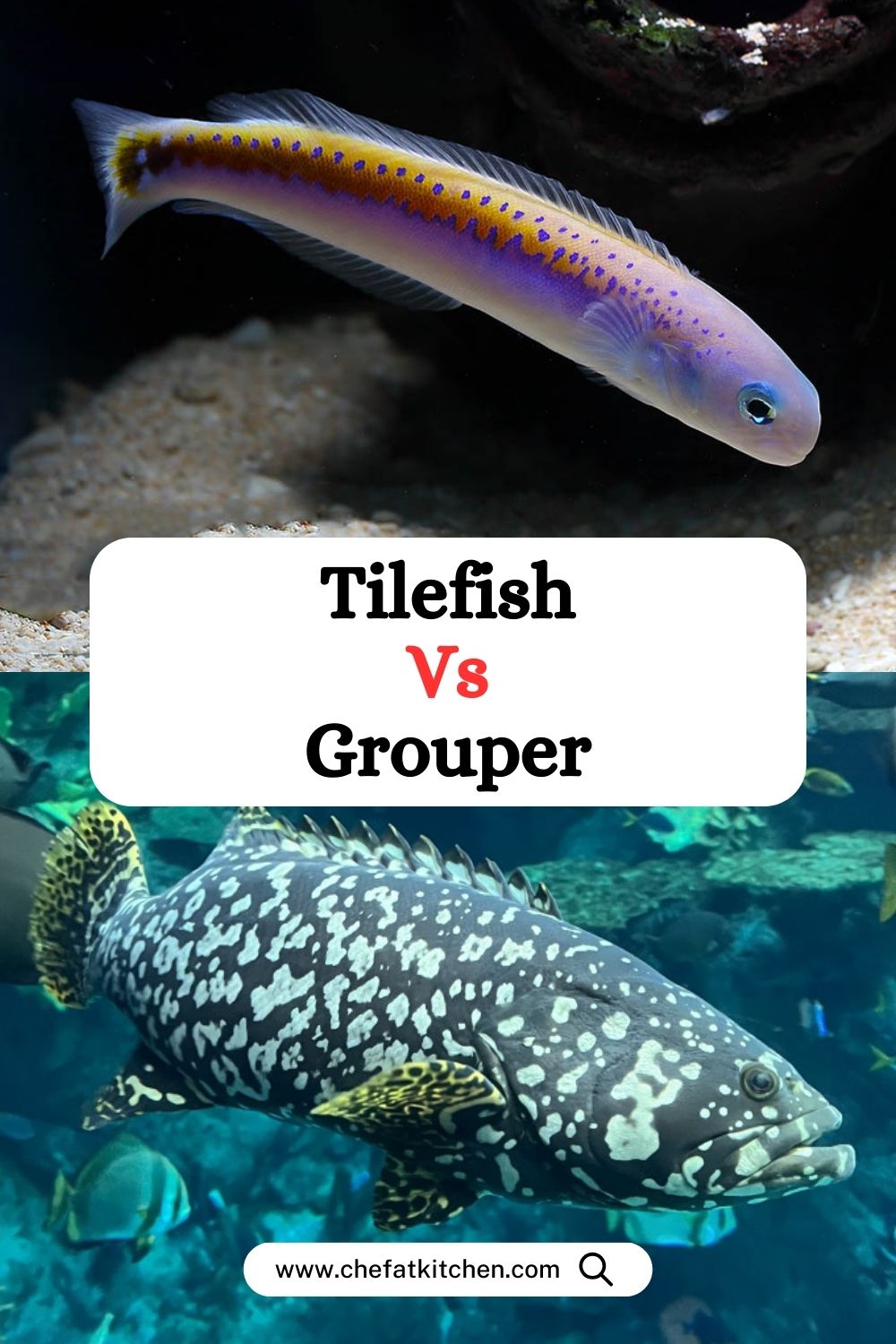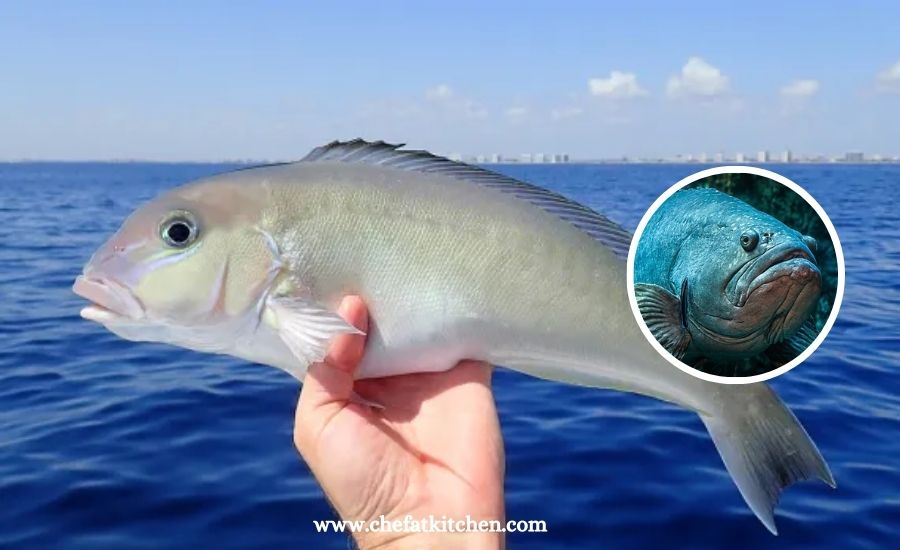Every product is independently reviewed and selected by our editors. If you buy something through our links, we may earn an affiliate commission at no extra cost to you.
Choosing the perfect fish for your next seafood feast, the options can be overwhelming.
Two popular choices that often find themselves in the spotlight are tilefish and grouper. Both boast unique flavors and textures, making them favorites among seafood enthusiasts.
In this culinary showdown, we’ll explore the characteristics of tilefish and grouper to help you make an informed decision for your next delicious meal.
Tilefish Vs Grouper – Quick Overview

Tilefish and grouper are both types of saltwater fish, and they are popular choices in seafood cuisine.
However, there are differences between the two:
| Feature | Tilefish | Grouper |
|---|---|---|
| Flavor | Mild and sweet | Strong and distinct |
| Texture | Firm and meaty | Flaky and tender |
| Habitat | Deep waters along the Atlantic coast | Atlantic and Pacific oceans |
| Cooking Methods | Versatile (grilled, baked, broiled, etc.) | Versatile (grilling, frying, baking, etc.) |
| Nutritional Value | Lean protein, low in fat, source of omega-3 fatty acids | Lean protein, source of omega-3 fatty acids, generally higher in fat compared to tilefish |
| Best Used For | Dishes that require a subtle, non-overpowering flavor | Dishes where a bold seafood flavor is desired |
| Popularity | Gaining popularity for its delicate taste | Widely popular for its robust flavor |
When choosing between tilefish and grouper, personal preference, availability, and sustainability considerations should all be taken into account.
Additionally, being aware of the specific species and their respective characteristics can further inform your decision.
Physical Characteristics
When it comes to identifying and differentiating between different types of fish, understanding their physical characteristics is key.
In this section, we will explore the coloration, size, and shape of Tilefish and Grouper, two popular species that are often compared.
Let’s dive in:
Coloration
Both Tilefish and Grouper come in a variety of beautiful colors that make them visually stunning.
However, there are some distinct differences in their coloration.
- Tilefish: These fish are known for their vibrant hues, ranging from bright yellow and gold to orange and red. They often have intricate patterns and markings, making them a favorite among deep-sea enthusiasts.
- Grouper: Grouper, on the other hand, sport a more subdued color palette. They typically have shades of brown, gray, and olive, helping them blend in with their surroundings
Size And Shape
For size and shape, Tilefish and Grouper exhibit some notable differences.
- Tilefish: Tilefish are generally smaller in size compared to Grouper. They usually measure around 12 to 19 inches in length, with a slender body and a compressed shape. Their small size makes them prized catches for recreational anglers.
- Grouper: Grouper, on the other hand, can grow to much larger sizes. Some species can reach astonishing lengths of over 8 feet and can weigh several hundred pounds. They have a robust and elongated body, which is adapted for living in coral reefs and rocky habitats.
Understanding the physical characteristics of Tilefish and Grouper not only helps in identification but also provides insight into their behavior and habitat preferences.
Whether you’re an angler or simply fascinated by marine life, knowing the differences between these two species can enrich your understanding of these incredible creatures.
Habitat
Understanding the habitat of a fish species is essential in determining its behavior, feeding habits, and overall suitability for different fishing grounds.
In the case of tilefish and grouper, their habitats play a significant role in shaping their characteristics and availability in various fishing areas.
Natural Environment
Tilefish and grouper have distinct natural environments where they are commonly found.
Tilefish, also known as golden tilefish, inhabit the deep waters of the Atlantic Ocean, particularly in the western Atlantic from Nova Scotia to Argentina.
On the other hand, grouper species are widely distributed across different oceans around the world, including the Atlantic, Indian, and Pacific Oceans.
Preferred Depth
To preferred depth, tilefish and grouper exhibit some differences.
Tilefish tend to thrive in deeper waters, typically between 250 and 1,500 feet deep.
In contrast, grouper species have a wider depth range, with some species found in shallower waters as shallow as 10 feet, while others can be found in depths of more than 1,000 feet.
By adapting to their specific preferred depths, tilefish and grouper are able to survive and thrive in their respective environments.
This segregation in depth preferences also impacts the availability of these species to commercial and recreational fishermen, as it requires different fishing techniques and equipment depending on the targeted species.
Overall, having an understanding of the natural environment and preferred depths of tilefish and grouper can greatly assist fishermen in effectively targeting and catching these fish species.
The habitat is a crucial factor that helps determine the distribution, behavior, and availability of fish, making it an essential consideration for those seeking to maximize their fishing success.
Behavior
Tilefish and Grouper, both belonging to the family of fish, exhibit distinctive behaviors that are essential for their survival.
Let’s delve into their behavioral patterns to gain insight into their fascinating characteristics.
Feeding Habits
Tilefish: Tilefish are opportunistic feeders and primarily consume benthic invertebrates such as worms, crustaceans, and mollusks.
They are known to use their elongated bodies to dig into the sediment in search of food.
Grouper: Grouper are carnivorous predators with a diverse diet, feeding on small fish, crabs, and cephalopods.
They are ambush predators, using their powerful jaws to engulf prey with swift precision.
Reproduction
Tilefish: Tilefish undertake intricate courtship rituals, often involving the creation of sand mounds on the ocean floor.
Females deposit their eggs in these mounds, and males diligently guard the nests to ensure the survival of the offspring.
Grouper: Grouper exhibit complex mating behavior, gathering in large spawning aggregations during specific times of the year.
These aggregations facilitate the release and fertilization of eggs, contributing to the successful reproduction of their species.
Nutritional Value
To comparing tilefish and grouper, considering their nutritional value is crucial.
Understanding the differences in their protein content, vitamins, and minerals can help you make informed decisions about incorporating these fish into your diet.
Protein Content
Both tilefish and grouper offer high protein content, which is essential for muscle growth and repair.
A 3-ounce serving of tilefish contains approximately 20 grams of protein, while the same serving size of grouper provides around 16 grams of protein.
Vitamins And Minerals
Both tilefish and grouper are rich in essential vitamins and minerals.
Tilefish is an excellent source of vitamin B12, which is crucial for nerve function and DNA production.
Meanwhile, grouper contains significant amounts of vitamin D, vital for bone health and immune function. Both fish also provide essential minerals such as selenium and potassium.
What Is The Difference Between Tilefish And Grouper?
Tilefish and grouper are both popular types of fish, but they have some key differences.
Tilefish has a mild, sweet flavor and a flaky texture, while grouper has a firmer texture and a flavor that is often described as a cross between bass and halibut.
Additionally, tilefish is known for its high mercury content, so it should be consumed in moderation.
Which Fish Is Healthier – Tilefish Or Grouper?
For health benefits, grouper is the winner. Grouper is a low-fat, high-protein fish that contains omega-3 fatty acids, vitamins, and minerals.
Tilefish, on the other hand, has a higher mercury content, which can be harmful if consumed in large quantities.
It’s always best to check with your doctor or a nutritionist to determine which fish is suitable for your dietary needs.
Are Tilefish And Grouper Both Sustainable Choices?
Tilefish and grouper have different sustainability ratings.
While some types of grouper, such as black grouper, are considered sustainable choices, others, like red grouper, may be overfished.
Tilefish, particularly golden tilefish, is currently overfished and has a lower sustainability rating.
If you’re concerned about sustainability, it’s recommended to choose grouper varieties that are marked as sustainable by organizations like Seafood Watch.
How Should Tilefish And Grouper Be Cooked?
Both tilefish and grouper are versatile to cooking methods. They can be grilled, baked, sautéed, or used in soups and stews.
The key is to avoid overcooking, as both fish tend to dry out easily.
Aim for a flaky, moist texture by cooking them for a short amount of time over medium heat.
Season with herbs, spices, and your favorite marinades to enhance the flavor.
Conclusion
In the tilefish vs grouper culinary showdown, the choice ultimately depends on your personal preferences and the flavor profile you seek in your seafood dishes.
Tilefish appeals to those who appreciate a milder taste and a firm texture, while grouper caters to those who crave a more robust and flavorful experience.
Whichever you choose, both tilefish and grouper promise a delightful addition to your culinary repertoire, bringing the ocean’s bounty to your dining table.

